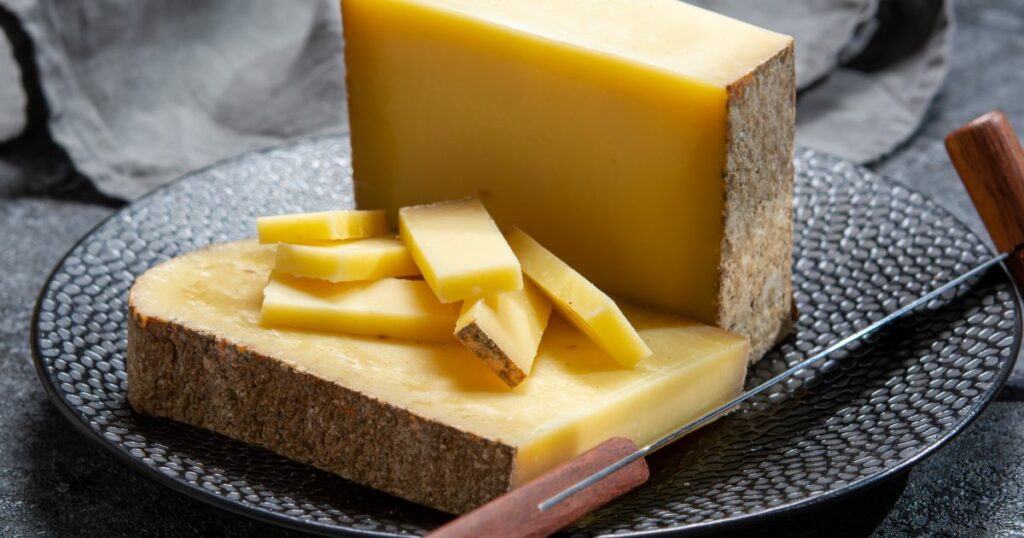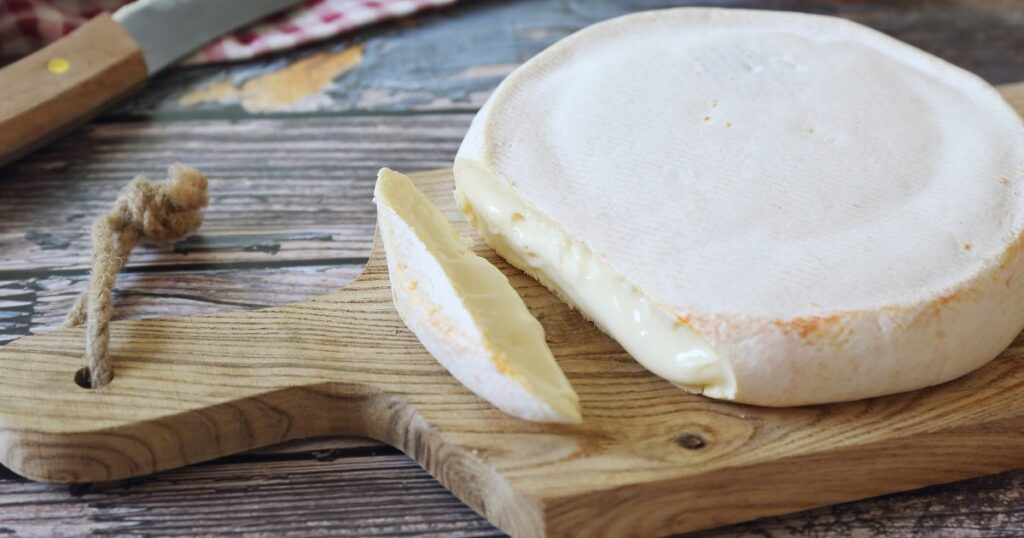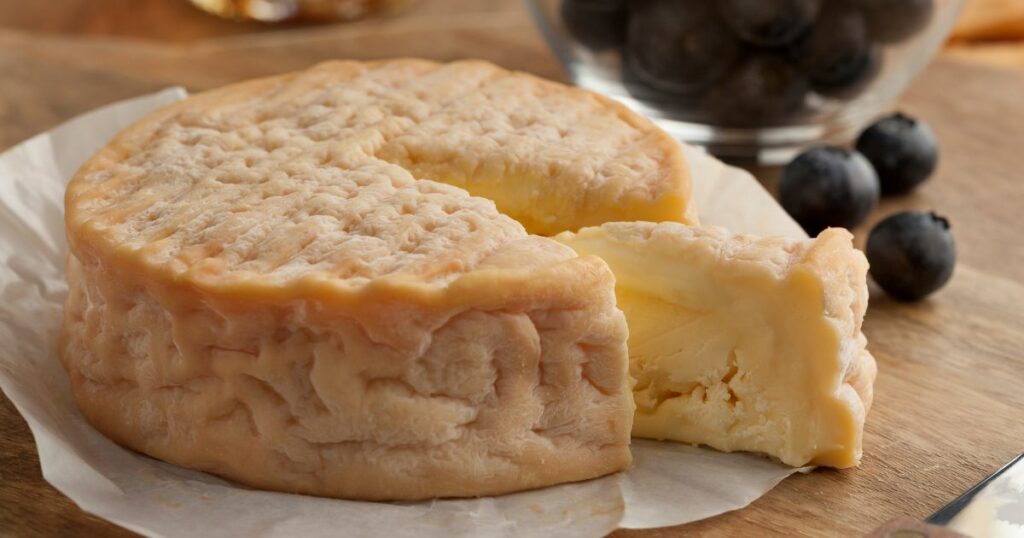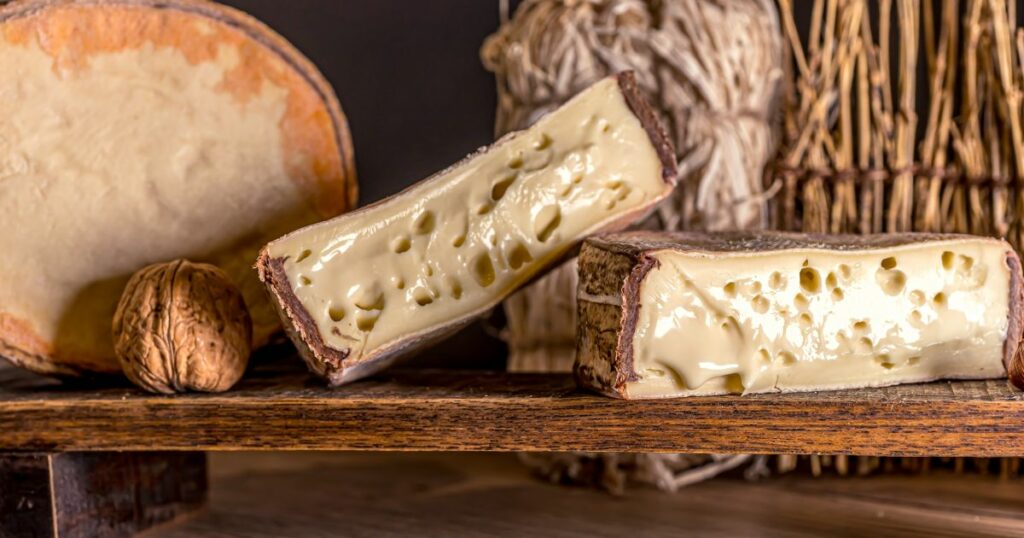Camembert: The Creamy Classic

Camembert is an iconic French cheese known for its soft, creamy texture and delicate, earthy flavor. Originating from Normandy, this cheese is made from cow’s milk and typically aged for three to four weeks. Its white, bloomy rind is entirely edible and adds a subtle, mushroomy taste. A well-made Camembert should be smooth and creamy, with a slightly runny center when ripe.
Classic pairing: Camembert is best enjoyed with a fresh, crusty baguette. The bread’s crunchiness contrasts beautifully with the cheese’s creaminess, creating a delightful sensory experience. Add a glass of fruity, medium-bodied red wine, such as a Pinot Noir or a Beaujolais, to round out the flavors.
Brie: The Queen of Cheeses

Often referred to as the “Queen of Cheeses,” Brie is another soft, creamy cow’s milk cheese, hailing from the Île-de-France region. Brie shares some similarities with Camembert, but its flavor is milder, buttery, and slightly sweet. The cheese is typically aged for four to five weeks, developing a bloomy, edible white rind that adds a touch of earthiness.
Classic pairing: Brie pairs wonderfully with a variety of fruits, such as grapes, figs, or apples. The sweetness of the fruit complements the cheese’s mild flavor. A slightly sweet, crisp white wine like Chardonnay or a light red wine like a young Pinot Noir will help bring out the best in Brie.
Roquefort: The Bold Blue

Roquefort, a blue cheese made from sheep’s milk, is one of the oldest and most famous French cheeses. Produced exclusively in the Roquefort-sur-Soulzon caves in southern France, this pungent cheese is aged for at least three months. Its distinctive blue veins are the result of Penicillium roqueforti, a mold unique to the region’s caves. Roquefort offers a sharp, tangy taste with a hint of sweetness and a crumbly, slightly moist texture.
Classic pairing: Classic Pairing: The bold flavor of Roquefort pairs excellently with sweet accompaniments like honey, figs, or walnuts. To enhance its flavors, try it with a glass of sweet dessert wine, such as Sauternes, or a robust red like a Cabernet Sauvignon.
Comté: The Sophisticated Hard Cheese

Comté is a popular hard cheese made from cow’s milk in the Jura region of eastern France. Aged for a minimum of four months (but often longer), Comté boasts a nutty, slightly sweet flavor with a hint of fruitiness. Its firm, dense texture makes it perfect for grating or slicing. With over 83 distinct flavors identified in Comté, this cheese offers a complex, layered taste experience.
Classic pairing: Comté is delicious when paired with charcuterie, such as prosciutto or salami, and crusty bread or crackers. Its nutty flavor also complements dried fruits like apricots or cherries. For a perfect wine match, choose a full-bodied white like a Chardonnay, or a light red such as a Pinot Noir.
Reblochon: The Alpine Treasure

Reblochon is a semi-soft, washed-rind cheese made from cow’s milk in the Haute-Savoie region of the French Alps. With a velvety, pale yellow rind and a smooth, supple interior, Reblochon is known for its mild, nutty flavor and delicate aroma. It is aged for four to six weeks and is a key ingredient in traditional Savoyard dishes, such as tartiflette.
Classic pairing: Reblochon pairs wonderfully with boiled or steamed potatoes and cornichons, creating a simple yet satisfying dish. To enhance the flavors, enjoy it with a crisp, refreshing white wine like a Sauvignon Blanc or a medium-bodied red like a Gamay.
Époisses: The Pungent Wonder

Époisses is a strong, pungent washed-rind cheese made from cow’s milk in the Burgundy region of France. Aged for about six weeks, its sticky, reddish-orange rind is washed in brine and local Marc de Bourgogne brandy, giving it a distinctive aroma and a complex, salty flavor. Époisses is creamy and gooey, with a slightly grainy texture.
Classic pairing: Époisses is best enjoyed with a hearty, crusty bread that can hold up to its bold flavor. Pair it with dried fruits like apricots or cherries for a delightful contrast in taste. As for wine, opt for a bold red like a Burgundy Pinot Noir or a full-bodied white like a Chardonnay.
Saint-Nectaire: The Volcanic Delight

Saint-Nectaire is a semi-soft, washed-rind cheese made from cow’s milk in the Auvergne region of central France. Produced in an area rich with volcanic soil, this cheese is aged for four to eight weeks and features a unique, fruity flavor with hints of hazelnut and mushroom. The rind of Saint-Nectaire is typically grayish and slightly sticky, while the interior is smooth and supple.
Classic pairing: Saint-Nectaire pairs well with fresh, crusty bread or crackers, as well as sweet fruits like pears or grapes. Enjoy this cheese with a medium-bodied red wine, such as a Pinot Noir, or a fruity white wine like a Chenin Blanc.
Munster: The Alsatian Star

Munster is a strong, pungent washed-rind cheese made from cow’s milk in the Alsace region of northeastern France. Aged for at least five weeks, Munster has a striking orange rind and a soft, creamy interior. Its flavor ranges from mild to intense, depending on the degree of maturation, with a distinctive tangy and slightly salty taste.
Classic pairing: Munster is traditionally served with boiled potatoes and finely chopped onions, creating a hearty and flavorful dish. To balance its strong flavors, pair this cheese with a fruity, aromatic white wine like a Gewürztraminer or a light red wine like a Pinot Noir.
Fourme d’Ambert: The Ancient Blue

Fourme d’Ambert is one of France’s oldest blue cheeses, with a history dating back to Roman times. Made from cow’s milk in the Auvergne region, this cheese is aged for at least 28 days and features a unique cylindrical shape. Fourme d’Ambert has a mild, creamy flavor with a gentle blue tang and a subtle sweetness, making it an excellent choice for those new to blue cheese.
Classic pairing: Fourme d’Ambert pairs beautifully with sweet accompaniments, such as honey, figs, or pear slices. For a delightful contrast in flavors, enjoy this cheese with a glass of sweet dessert wine like a Port or a fortified Banyuls.
Sainte-Maure de Touraine: The Elegant Goat Cheese

Sainte-Maure de Touraine is a delicate, ash-coated goat cheese from the Loire Valley in central France. This log-shaped cheese has a thin, edible rind and a smooth, dense interior. Aged for at least 10 days, Sainte-Maure de Touraine features a subtle, tangy flavor with a hint of earthiness and a characteristic ashed center.
Classic pairing: Sainte-Maure de Touraine is delightful when paired with fresh, crusty bread, and a drizzle of honey or a spoonful of fruity preserves. To enhance its flavors, serve it with a crisp, refreshing white wine like a Sauvignon Blanc or a light, fruity red like a Gamay.
Conclusion
From creamy Camembert to pungent Époisses, France offers an incredible array of cheeses that delight the senses and showcase the country’s rich culinary traditions. Whether you’re a cheese connoisseur or a curious food lover, exploring these top French cheeses and their classic pairings will elevate your appreciation for this delicious and versatile ingredient. As you embark on this flavorful journey, remember to savor each cheese’s unique taste and texture, and don’t be afraid to experiment with different pairings to find your perfect match. Bon appétit!
𐡸 𐡸 𐡸 𐡸 𐫱 𐡷 𐡷 𐡷 𐡷
Frequently asked questions
Some of the most popular French cheeses include Camembert, Brie, Roquefort, Comté, Reblochon, and Époisses. Each cheese has a unique flavor and texture, reflecting the rich variety of France’s culinary heritage.
To preserve their quality and flavor, store cheeses in the refrigerator, wrapped in wax or parchment paper. This will allow them to breathe while maintaining freshness. Avoid using plastic wrap, as it can suffocate the cheese and alter its flavor.
A ripe French cheese should have a pleasant aroma and a slightly soft, yielding texture when pressed gently. Some cheeses, like Camembert and Brie, will become more runny at room temperature when ripe. Always allow the cheese to sit at room temperature for about 30 minutes before serving to fully appreciate its flavors and textures.
The traditional cheese used in French Onion Soup is Gruyère, a firm, nutty cheese made from cow’s milk. Gruyère is known for its excellent melting properties, creating a rich, gooey layer atop the soup. Alternatives include Comté or Emmental, which also melt well and provide a delicious, savory flavor.
France is home to a vast array of cheeses, with over 1,000 different varieties produced across the country. This rich diversity showcases the wide range of flavors, textures, and techniques found in French cheese-making. From soft and creamy Brie to pungent Roquefort, there’s a French cheese to suit every palate.



